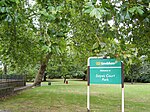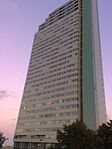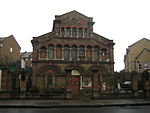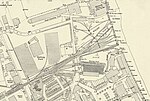Convoys Wharf

Convoys Wharf, formerly called the King's Yard, is the site of Deptford Dockyard, the first of the Royal Dockyards, built on a riverside site in Deptford, by the River Thames in London, England. It was first developed in 1513 by Henry VIII to build vessels for the Royal Navy. Convoys Wharf also covers most of the site of Sayes Court manor house and gardens, home of diarist John Evelyn. The site was owned until 2008 by News International, which used it to import newsprint and other paper products from Finland until early 2000. It is now owned by Hutchison Whampoa Limited and is subject to a planning application to convert it into residential units, although a large part of the site has safeguarded wharf status.The eastern area adjoining Watergate Street was Palmers Wharf.
Excerpt from the Wikipedia article Convoys Wharf (License: CC BY-SA 3.0, Authors, Images).Convoys Wharf
Dacca Street, London New Cross (London Borough of Lewisham)
Geographical coordinates (GPS) Address Website External links Nearby Places Show on map
Geographical coordinates (GPS)
| Latitude | Longitude |
|---|---|
| N 51.486 ° | E -0.027 ° |
Address
Convoys Wharf
Dacca Street
SE8 3LJ London, New Cross (London Borough of Lewisham, Sayes Court Estate)
England, United Kingdom
Open on Google Maps










